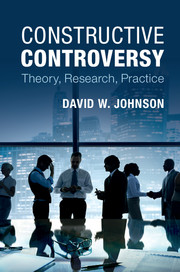Book contents
- Frontmatter
- Contents
- List of figures
- List of tables
- Acknowledgments
- 1 Underlying foundations of constructive controversy
- 2 The nature of constructive controversy
- 3 Theory of constructive controversy
- 4 The processes of constructive controversy and concurrence seeking
- 5 The outcomes of constructive controversy
- 6 Conditions mediating the effects of constructive controversy
- 7 Constructive controversy and decision making
- 8 Constructive controversy in education
- 9 Constructive controversy and political discourse in democracies
- 10 Constructive controversy, creativity, and innovation
- 11 Constructive controversy and building and maintaining peace
- 12 Conclusions
- References
- Index
11 - Constructive controversy and building and maintaining peace
Published online by Cambridge University Press: 05 June 2015
- Frontmatter
- Contents
- List of figures
- List of tables
- Acknowledgments
- 1 Underlying foundations of constructive controversy
- 2 The nature of constructive controversy
- 3 Theory of constructive controversy
- 4 The processes of constructive controversy and concurrence seeking
- 5 The outcomes of constructive controversy
- 6 Conditions mediating the effects of constructive controversy
- 7 Constructive controversy and decision making
- 8 Constructive controversy in education
- 9 Constructive controversy and political discourse in democracies
- 10 Constructive controversy, creativity, and innovation
- 11 Constructive controversy and building and maintaining peace
- 12 Conclusions
- References
- Index
Summary
INTRODUCTION
The Kurds live in Turkey, Iran, and Iraq. When the boundaries of these countries were drawn, the Kurds were deliberatively divided into three different countries. What has resulted is a political tension in all three countries, as many Kurds wish to separate from the three countries and form their own state of Kurdistan. In the national discussions of Turkey, Iran, and Iraq, as well as in regional discussions, the issue of the possibility of a Kurdish state must always be addressed. Each country wishes to keep their Kurdish territory and citizens. The same may or may not be true of the Kurds. It is a difficult problem that will not go away in the near future. How may this and similar problems be discussed throughout the world? One answer is through the constructive controversy process.
In a very oversimplified way, a regional committee could be divided into two subgroups. Subgroup A could be assigned the position that the Kurds should give up their dream of a Kurdish state and identify with the country of which they are citizens. Subgroup B could be assigned the position that the Kurds should separate from the three countries and form their own state of Kurdistan. While the constructive controversy procedure is followed, the emphasis is on understanding the issue from both perspectives and coming up with a synthesis that allows both views to achieve their goals. It is not that one side should win and the other lose; rather the challenge is to find a creative way for both sides to get what they want in a way that stabilizes the region and brings lasting peace.
Thus, another important application of constructive controversy procedures is in the establishment and maintenance of world peace. In discussing the role of constructive controversy in world peace, the nature of interventions will be noted, the need for constructive controversy to manage discussions of difficult issues will be discussed, the nature of peace will be discussed, the types of peace will be noted, the nature of peace education will be discussed, the five steps of implementing a process for teaching peace education will be delineated, and the need for automaticity in implementing the constructive controversy process will be discussed.
- Type
- Chapter
- Information
- Constructive ControversyTheory, Research, Practice, pp. 180 - 200Publisher: Cambridge University PressPrint publication year: 2015



